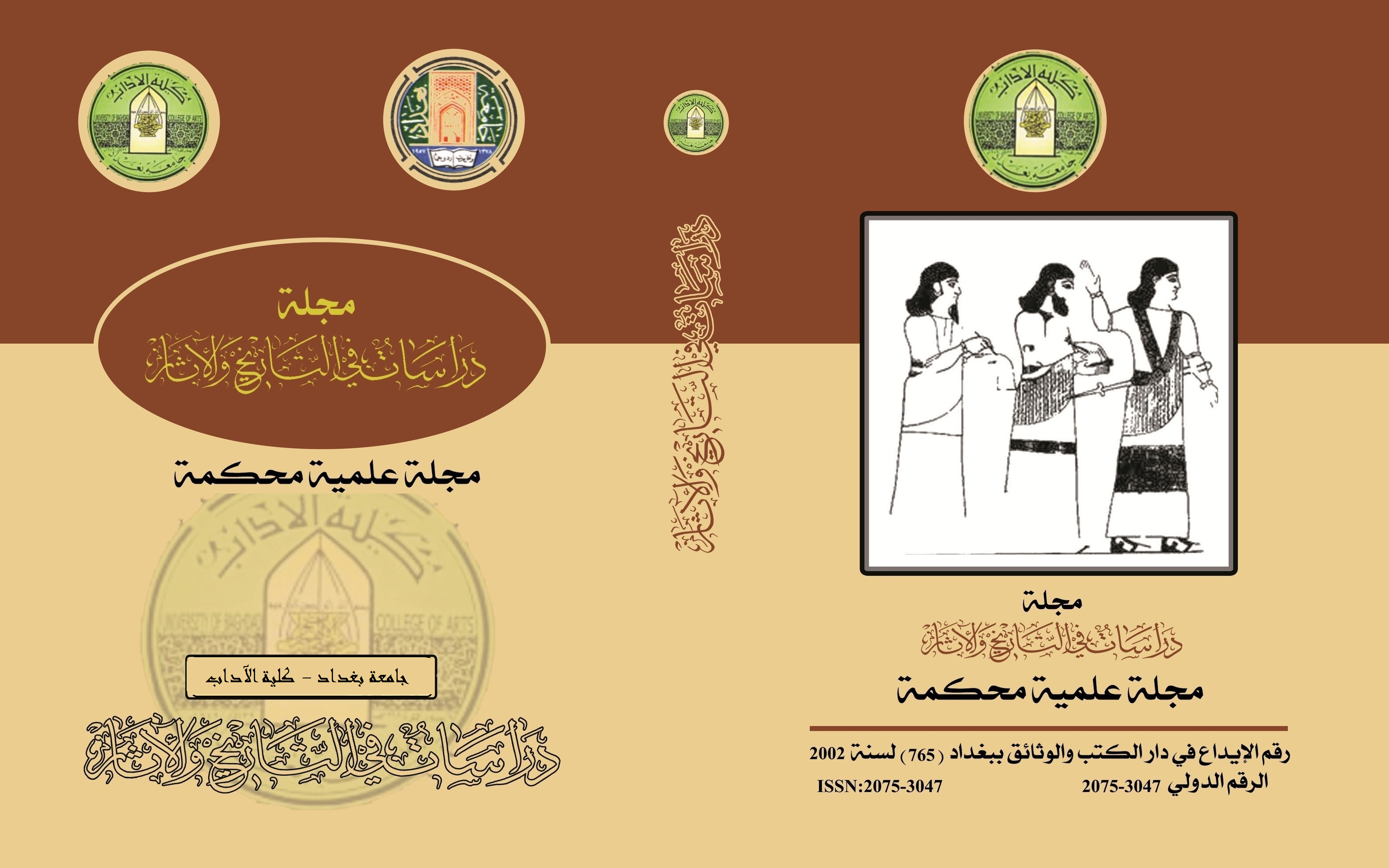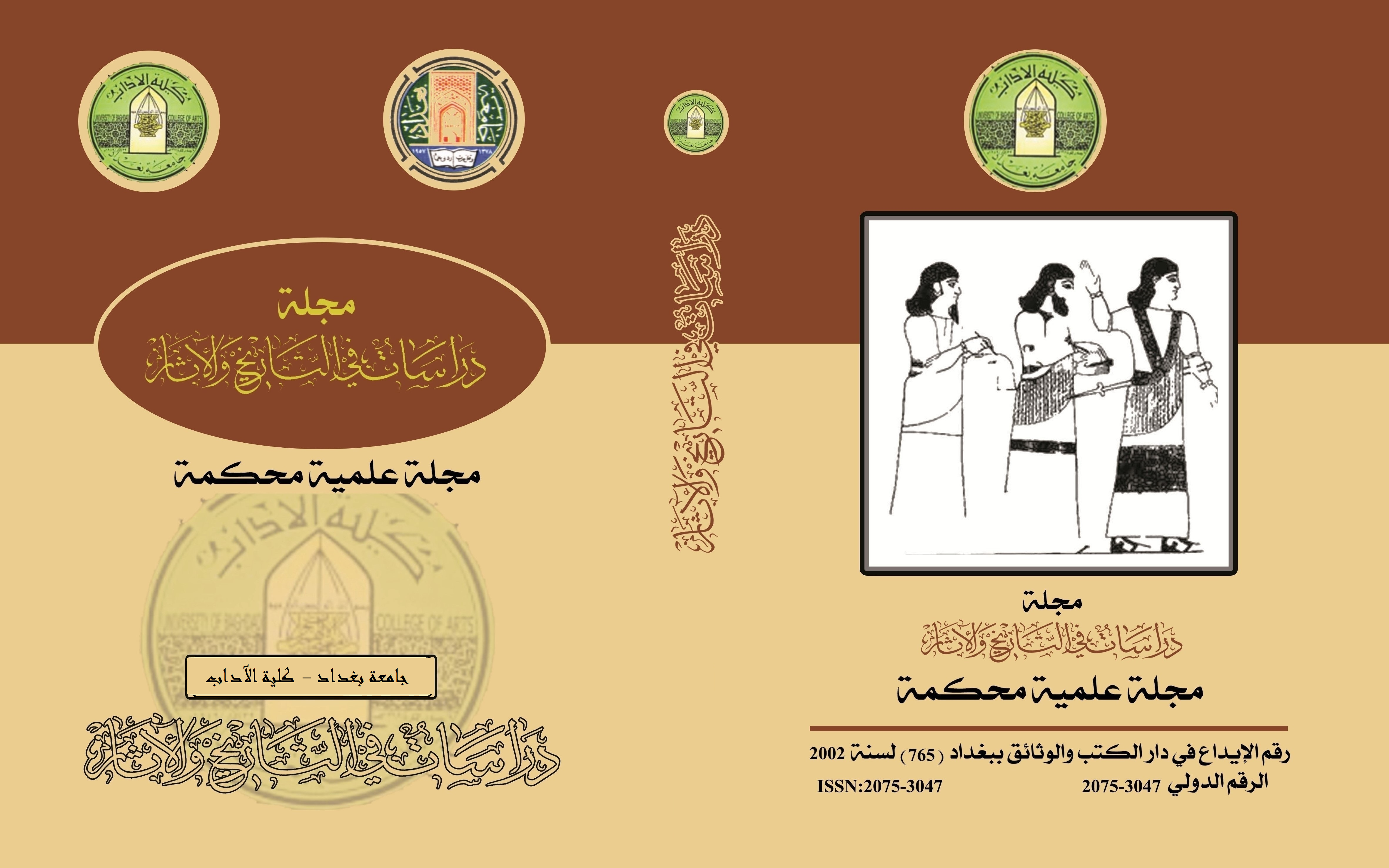سوق الصاغة وصناعة المجوهرات في مصر الفاطمية
الكلمات المفتاحية:
الحلي، البيت الفاطمي، مصر، خزائن الجوهر، الزخارفالملخص
أضاف الفاطميون الى ثراء مصر وغناها ثراء اكبر بما جلبوه معهم من أموال وثروات وتضم معادن نفيسة كالذهب والفضة .
حيث اغرم الكثير من أبناء البيت الفاطمي وعلى رأسهم الخلفاء باقتناء الجوهر الى حد اتخاذهم وكلاء ينوبون عنهم لشرائها ، حيث كان لهم سوق للجوهر وان نساء القصر انصب جل اهتمامهن على جمع قطع الحلي ، لذلك قام الخلفاء الفاطميون ببناء خزائن للجوهر في قصورهم التي كانت تزخر بقطع الحلي والجواهر .
شاعت في العصر الفاطمي عدة طرق وأساليب لصناعة الحلي وزخرفتها ، حيث عرفوا طريقة الحز والحفر ، وكثر عندهم الترصيع بالأحجار الكريمة . فقد صاغ الفنان الفاطمي قطع الحلي واستمد زخارفها من بعض العناصر الزخرفية المستوحاة من الفن الفارسي ، وكان قوام هذه الزخارف نقوش نباتية وهندسية واشكال وطيور وكتابات بالخط الكوفي
المراجع
• القران الكريم
أولا / المصادر المطبوعة
• ابن الجوزي ، شمس الدين علي بن عبد الله (ت654هـ / 1256م)
1. مرأة الزمان في تواريخ الاعيان ، (500-553هـ) ، تحقيق : إبراهيم الزئبق ، ط1 ( دمشق : الرسالة العالمية ، 2013م )
• ابن حماد الصنهاجي ، أبو عبد الله محمد بن علي (ت626هـ/1230م)
2. اخبار ملوك بني عبيد ، تحقيق : تشيده سليمان ،(الجزائر : معهد العلوم الاجتماعية ، 1979م)
• ابن خلكان ، أبو العباس شمس الدين أحمد بن علي (ت681ه/1282م)
3. وفيات الأعيان وأنباء أبناء الزمان، تحقيق: محمد عبد الرحمن المرعشلي،ط1(بيروت : دار أحياء التراث العربي، 1997م)
• الدمشقي ، أبي الفضل جعفر بن علي (من اعلام القرن السادس الهجري)
4. الإشارة الى محاسن التجارة ومعرفة جيد الاعراض وردبها وغشوش المدلسين فيها ، (د: م ، مطبعة المؤيد ، 1318هـ)
• الرشيد ابن الزبير (ت في القرن الخامس الهجري )
5. الذخائر والتحف ، حققه : محمد حميد الله ، قدم له وراجعه ، صلاح الدين المنجد ، ( الكويت :التراث العربي ، 1959م)
• المقريزي ، احمد بن علي (ت845هـ/ 1441م)
6. اتعاظ الحنفا بأخبار الائمة الفاطميين الخلفاء ، حققه : جمال الدين الشيال ،ط1( القاهرة : لجنة احياء التراث الإسلامي ، د. ت)
7. المقفى الكبير ،تحقيق ، محمد اليعلاوي ، ط2( بيروت : دار الغرب الإسلامي ، 2006م)
8. المواعظ والاعتبار بذكر الخطط والاثار المعروف بالخطط المقريزية ، ط1( بيروت : دار الكتب العلمية ، 1418هـ)
• ابن ميسر ، محمد بن علي (ت667هـ/1278م)
9. اخبار مصر ، (القاهرة : طبعة هنري ، 1988م)
ثانيا / المراجع العربية
• العاملي ، زينب بنت علي بن حسين (ت1332هـ/ 1913م)
10- الدر المنثور في طبقات ربات الخدور ، ط1(مصر : مطبعة الكبرى الاميرية ، 1312هـ)
• الوائلي ، عبد الحكيم
11- موسوعة الأحجار الكريمة (عمان : دار أسامة ، 2001م)
• ول ديوانت
12- قصة الحضارة ، ط2(القاهرة : جامعة الدول العربية ، 1964م)
1. Quran
I. Printed Sources
• Ibn al-Jawzi, Shams al-Din Ali ibn Abdullah (d. 654 AH / 1256 AD)
1. The Woman of Time in the Dates of Notables - (500-553 AH) - achieved by: Ibrahim Al-Za'iq - 1st Edition (Damascus: The Global Message, 2013 AD)
• Ibn Hammad al-Sinhaji, Abu Abdullah Muhammad ibn Ali (d. 626 AH/1230 CE)
2. News of the kings of Bani Obaid, achieved by: Tasida Suleiman, (Algeria: Institute of Social Sciences, 1979 AD)
• Ibn Khalkan, Abu al-Abbas Shams al-Din Ahmad ibn Ali (d. 681 AH/1282 AD)
3. The deaths of notables and the news of the sons of time, investigated by: Muhammad Abdul Rahman Al-Marashli, 1st Edition (Beirut: House of Arab Heritage Neighborhoods, 1997 AD)
• Al-Dimashqi, Abu al-Fadl Jaafar bin Ali (from the flags of the sixth century AH)
4. Referring to the merits of trade and knowing the good symptoms and their rejection and the fraud of those who deceive in it, (D: M, Al-Mu'ayyad Press, 1318 AH)
• Al-Rashid Ibn Al-Zubayr (d. in the fifth century AH)
5. Ammunition and artifacts, edited by: Muhammad Hamid Allah, presented to him and reviewed by Salah Al-Din Al-Munajjid, (Kuwait: Arab Heritage, 1959 AD)
• Al-Maqrizi, Ahmed ibn Ali (d. 845 AH / 1441 CE)
6. The Hanafi preaching the news of the Fatimid Imams - the Caliphs - achieved by: Gamal Al-Din Al-Shayyal - 1st Edition (Cairo: Committee for the Revival of Islamic Heritage - d. T.)
7. Al-Muqaffi Al-Kabir - investigated by Muhammad Al-Yalawi - 2nd Edition (Beirut: Dar Al-Gharb Al-Islami, 2006 AD)
8. Sermons and consideration by mentioning plans and effects known as Maqrizi plans, 1st edition (Beirut: Dar Al-Kutub Al-Ilmiyya, 1418 AH)
• Ibn Maysar, Muhammad ibn Ali (d. 667 AH/1278 CE)
9. Egypt News, (Cairo: Henry Edition, 1988)
Second / Arabic references
• Al-Amili, Zainab bint Ali bin Hussein (d. 1332 AH / 1913 AD)
10. Al-Durr Al-Manthur in the layers of Rabat Al-Khadoor, 1st Edition (Egypt: Al-Kubra Al-Amiri Press, 1312 AH)
• Alwaeli, Abdul Hakim
11. Encyclopedia of Gemstones (Amman: Dar Osama, 2001)
• Well Diwan
12. The Story of Civilization, 2nd Edition (Cairo: League of Arab States, 1964 AD)
التنزيلات
منشور
إصدار
القسم
الرخصة

هذا العمل مرخص بموجب Creative Commons Attribution 4.0 International License.
:حقوق الطبع والنشر والترخيص
بالنسبة لجميع البحوث المنشورة في مجلة دراسات في التاريخ والآثار، يحتفظ الباحثون بحقوق النشر. يتم ترخيص البحوث بموجب ترخيص Creative Commons CC BY 4.0 المفتوح ، مما يعني أنه يجوز لأي شخص تنزيل البحث وقراءته مجانًا. بالإضافة إلى ذلك ، يجوز إعادة استخدام البحث واقتباسه شريطة أن يتم الاستشهاد المصدر المنشور الأصلي. تتيح هذه الشروط الاستخدام الأقصى لعمل الباحث وعرضه.
:إعادة إنتاج البحوث المنشورة من الناشرين الآخرين
من الضروري للغاية أن يحصل الباحثون على إذن لإعادة إنتاج أي بحث منشورة (أشكال أو مخططات أو جداول أو أي مقتطفات من نص) لا يدخل في نطاق الملكية العامة أو لا يملكون حقوق نشرها. يجب أن يطلب الباحثون إذنًا من مؤلف حقوق النشر (عادة ما يكون الناشر).
يطلب الإذن في الحالات التالية:
بحوثك الخاصة المنشورة من قِبل ناشرين آخرين ولم تحتفظ بحقوق النشر الخاصة بها.
مقتطفات كبيرة من بحوث أي شخص أو سلسلة من البحوث المنشورة.
استخدم الجداول والرسوم البيانية والمخططات والمخططات والأعمال الفنية إذا لم يتم التعديل عليها.
الصور الفوتوغرافية التي لا تملك حقوق لنشرها.
لا يطلب الإذن في الحالات التالية:
إعادة بناء الجدول الخاص بك مع البيانات المنشورة بالفعل في مكان آخر. يرجى ملاحظة أنه في هذه الحالة يجب عليك ذكر مصدر البيانات في شكل "بيانات من ..." أو "مقتبس من ...".
تعتبر عروض الأسعار القصيرة معقولة الاستخدام العادل ، وبالتالي لا تتطلب إذنًا.
الرسوم البيانية ، الرسوم البيانية ، المخططات ، الأعمال الفنية التي أعاد الباحث رسمها بالكامل والتي تم تغييرها بشكل ملحوظ إلى درجة لا تتطلب الاعتراف.
الحصول على إذن
لتجنب التأخير غير الضروري في عملية النشر ، يجب أن تبدأ في الحصول على أذونات في أقرب وقت ممكن. لا يمكن لمجلة الآداب نشر بحث مقتبس من منشورات أخرى دون إذن.
قد يمنحك مالك حقوق الطبع والنشر تعليمات بشأن شكل الإقرار الواجب اتباعه لتوثيق عمله ؛ بخلاف ذلك ، اتبع النمط: "مستنسخ بإذن من [المؤلف] ، [كتاب / المجلة] ؛ نشره [الناشر] ، [السنة]." في نهاية شرح الجدول ، الشكل أو المخطط.



















